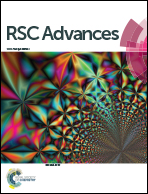Preparation and properties of polyacrylamide/polyvinyl alcohol physical double network hydrogel†
Abstract
A novel physical double network hydrogel (PDN gel) composed of physically cross-linked PVA and hydrophobically associated polyacrylamide (HAPAM) has been successfully prepared by one-pot in situ polymerization and subsequent freeze–thaw cycling. FTIR and XRD analysis showed the presence of two unique mechanisms that contribute to the PDN gels' mechanical properties. Strong hydrogen bonds between PVA and PAM chains and crystallization of PVA were responsible for the enhancement in mechanical strength of PDN gels. The impact of crystallization during freeze–thaw cycling was investigated by comparing freeze–thawed PDN and Semi-IPN HAPAM/PVA hydrogels. The crystallinity and mechanical properties of the PDN hydrogels were also evaluated as a function of the number of cycles and the content of PVA. Moreover, the PDN hydrogels exhibit self-healing capability and good anti-fatigue properties stemming from the physical network of PVA and HAPAM by virtue of the extensive interchain hydrogen bonding between the hydroxyl side groups and the network structure reorganization of hydrophobically associated polyacrylamide. This study thus demonstrates a general approach to improve the mechanical properties and self-healing efficiency of hydrogels by combining the synergistic cross-linking effects provided by hydrophobically associated micelles and crystalline microdomains.


 Please wait while we load your content...
Please wait while we load your content...